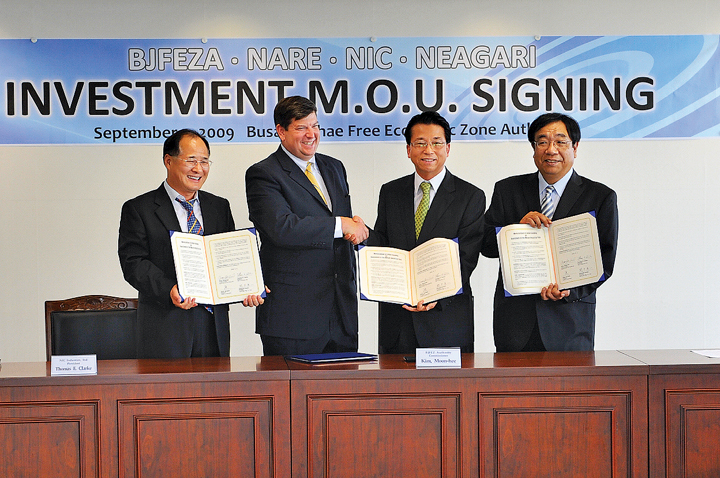Officials of the Busan-Jinhae Free Economic Zone recently visited
Targeting U.S.-based renewable energy companies and logistics firms, the road show made contacts in multiple American cities from Aug. 21 to Sept. 10.
The goal of the global port at the southeastern tip of the Korean peninsula is to convince more American companies to invest in corporate facilities at the 26,000-acre (10,530-hectare) complex in northeast
Established five years ago, the zone is showing signs of progress. On Sept. 2, the BJFEZ Authority signed a memorandum of understanding with an international consortium including NIC of the
The agreement calls for the joint venture of NIC, Neagari and Nare of Korea to lease 10,000 sq. m. of space for the purpose of manufacturing forged parts and machinery for the automotive and shipbuilding industries. The deal is valued at US$12 million.
The port’s new green strategy aims to grow and attract alternative-energy-based operations. By 2015, the Busan Port Authority headquarters will be fully converted to solar power. The port will also provide a land-based power-supply service for container vessels while they are berthed — eliminating their need to burn fossil fuels while in port. In addition, the port uses electric vehicles and cranes.
“The port’s green strategy is meant to create greater efficiencies by reducing operating expenses related to the use of fossil fuels,” says Andy Lee, spokesman for the BJFEZ Authority. “The green strategy means reduced operating expenses in energy costs to both the shipping companies as well as the port itself.”
FDI Fostered in Multiple Sectors
Busan-Jinhae FEZ officials followed up their “green tour” with a second road show in October — one designed to promote tourism, leisure and shipbuilding R&D opportunities in the zone.
“With the selection of the Yongwon/STX consortium as the preferred bidder for the Free Economic Zone’s Ungdong tourism project master developer, the authority [went] to the
The Ungdong Tourism Complex is a $246-million project designed to develop 2.26 million sq. m. of reclaimed land in and around Jaeduk-dong in
The second trip to
German shipbuiilder Hatlapa announced a $3.52-million project in the Jisa Foreign Investment Zone in April.
BJFEZ is one of six major free economic zones being developed by the national government of
New laws passed in 2008 made
Also, any foreign investor who invests more than US$500,000 and employs more than five Korean citizens is eligible to apply for permanent residency. Executives of foreign-based firms will be given travel cards that allow expedited entry into
This investment profile was prepared under the auspices of the Busan-Jinhae Free Economic Zone Authority. For more information, contact Lee Sang-Hoon, Director-General, at 82-51-979-5440. On the Web, go to www.bjfez.net.
